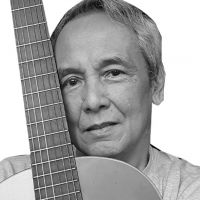Why not try not trying?

Throughout our lives, we have been taught to always try harder, improve ourselves, seek the better option, and go for the top. I remember how my school, parents and role models would urge me to push the envelope and defy my limitations. In many ways, I am grateful to them because I felt really good discovering that I was capable of so much more than I thought.
My mother told me that I could pursue any career I wanted as long as I did my best in my chosen field. This was, and still is, my guiding principle in life.
I have great respect for people who have bodies of work that illustrate what their lives are about, even if only in part. I speak of authors, musicians, architects, philosophers, artists — people who create for a living.
Their bodies of work can be seen as themes or narratives they have cultivated through different stages in their lives. These are documents or statements about what they thought and what they felt passionate about at different points in time.
A lifework can only be created if one is dedicated to pursuing one’s passions and dreams. And doing so necessarily leads to and becomes a quest for continuous improvement.
I look at the driving force behind a lifework as man’s striving for immortality. It is an assurance that their accomplishment will outlive them somehow, even just for a while.
But as I got older and was spiritually awakened, I stumbled upon a vital life skill that seems to be in contrast to the beliefs and attitudes I stated above. I discovered the virtue of acceptance. As I become more accepting, I am learning more and more that there is a time to strive and a time to stop resisting. Indeed, there is a time to just not do anything.
Instead of constantly trying to improve and changing the way things are, acceptance asks us to pause and not resist the forces that move around us. It wants us to detach from the need to fix things or make them perfect. It asks us to just let things unravel, to look at the world with all its faults, imperfections, wrongs, and accept it for what it is.
I once listened to a Joseph Campbell lecture on the mythical story of The Frog Prince. The young girl in the
fairytale was disgusted and sick to her stomach at the mere sight of the frog she had invited into her life, whom she had to eat and sleep with, as she had promised. And the prospect of having to kiss it was totally unbearable. She was in a bind. She had made a promise and it had to be kept. Sooner or later she had to do it.
But when she finally relented and kissed the frog, it magically turned into a prince. The lesson here is that life can only become beautiful once you accept how horrible and ugly it is. When you do, you stop feeling entitled to a perfect life and begin to work with its harsh realities. Then you discover its hidden joys and gifts.
And while that seems all good and nice, if you are coming from a social activist’s point of view, this “fatalism” can seem so wrong on many levels. Aren’t we supposed to change the world, to make things better for humanity? Should we just allow the degradation of the environment, ISIS and Ebola to run roughshod over humanity?
It is a conundrum.
I am consoled by the “Serenity Prayer” of Reinhold Niebuhr which goes, “God, grant me the serenity to accept the things I cannot change, the courage to change the things I can, and the wisdom to know the difference.”
It is a call to accept the yin with the yang, the “pair and unity of opposites” that is integral to life. Where there is joy, pain is not far behind. Where there is life, death is also present. Paradoxical, it is.
A paradox is a statement that seems like it is wrapped in contradiction, but upon deep reflection, turns out to be profoundly true. An example of this is the Christian adage that one must be willing to lose his life in order to gain it. Another one is the idea of a king born in a manger who will save the world. The late writer M. Scot Peck expressed the belief that all enduring truths are paradoxical in nature.
My 25-year old son Mio who recently visited from Sydney was complaining about the traffic and so many other things wrong in Manila. He said that he can’t accept the attitude of many Filipinos that “things are really just like this.” He spoke with the sureness of youth, and the experience of having lived elsewhere, where life is different, to back his denunciation.
Strangely, I found myself agreeing with him wholeheartedly even though I have pretty much settled with the reality of how life is here.
At my age, I already know that there is a time to struggle, to strive, to aspire, and to pursue and there is a time to just allow things to be or to unravel as they will. As Carl Jung put it, there are things that are true in the morning of life that stop being important in the afternoon.
Life, by its very nature, is filled with tension. To be physically alive, one must defy gravity and reject the pull of inertia. One can say that life itself is an act of defiance. But even as one fights certain forces in order to stay alive, one must also surrender to them — to rest, gather strength, reinvigorate and continue living. In the same way, musical notes must accommodate rests and silences for a melody to have coherence.
Do the things you must do and do your best, but try not to be attached to outcomes. Just do it. It’s as simple as that. As a creative, I know that trying to do creative work is the hardest thing. But by simply being creative, one effortlessly gets the job done. Why? Because it is not something that you must do. You simply must be who you are. There should be no effort in that.
Lao-Tzu said, “Practice non-doing and everything will fall into place.” This is not a call to be lazy, or to merely wish for things to happen. This is about going with the flow instead of trying too hard to survive it. It is the art of effortless doing, instead of “industrious” and frenzied action, that makes living life an art form.
















